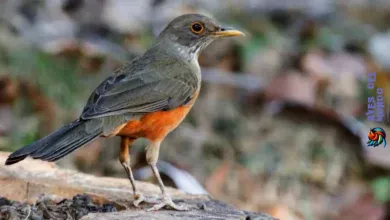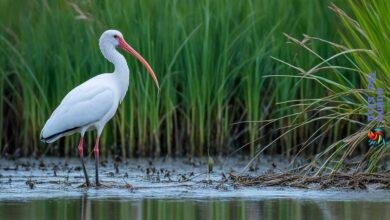In the depths of the South American wildlife, a figure hides in plain sight, so adept at blending in that 90% of passersby never notice its presence.

This creature is the elusive urutau, also known as the «Ghost Bird,» renowned for its almost supernatural ability to disappear within its environment. You might have heard tales of a nocturnal bird that personifies the very essence of mystery – and you wouldn’t be wrong. The urutau manifests nature’s ingenuity at its finest, making this enigmatic bird a subject of myths and fascination for anyone lucky enough to learn its secrets.
With its distinct traits that captivate observers and wildlife enthusiasts, the urutau thrives under the cover of darkness. Its large pupils, a marvel of evolutionary adaptation, provide enhanced night vision, critical for survival amongst the dense forestry of South America. These nocturnal adaptations are but a prelude to its compelling narrative – a story of survival, mystery, and an almost ethereal existence within the vast and varied ecosystem it calls home.
Unveiling the Enigmatic Urutau: Masters of Camouflage
When twilight descends upon the South American forests, the Urutau, a nocturnal marvel, becomes the epitome of natural stealth and cunning. For enthusiasts in bird-watching and nature photography, the allure of capturing such a creature is unmatched, compelling them to delve deeper into its secretive world. The principles of bird conservation also come to the forefront when considering the Urutau’s place in nature’s mosaic.
The Cryptic Plumage of the ‘Ghost Bird’
Camouflage is the Urutau’s forte, with its plumage seamlessly blending into the bark of trees. This evolutionary artwork confuses predators and prey alike, ensuring its guise as just another part of the tree it roosts on. Such camouflage prowess is a crucial topic for conservation discussions, as it highlights the intricate adaptations birds develop for survival.
Remarkable Physical Adaptations for Nocturnal Life

The Urutau is a quintessential example of nocturnal bird adaptation, crafted by nature for life under the cover of darkness. With enhanced eyesight through large pupils and a beak bordered by fine, sensory bristles, it is well-equipped for its nightly endeavors. These adaptations are, without doubt, facets that captivate those observing through lenses or binoculars.
Understanding the Urutau’s Unusual Hunting Techniques
Patience is a virtue well embodied by the Urutau. Utilizing sit-and-wait hunting techniques, it conserves energy by remaining motionless for extended periods until an unsuspecting insect ventures too close. This strategy is not just efficient but also a testament to the complex behaviors developed by birds to thrive in their environments.
| Adaptation | Advantage for Survival |
|---|---|
| Camouflaged plumage | Evasion of predators and stealthy hunting |
| Large pupils for improved night vision | Enhanced hunting efficiency in low light conditions |
| Beak with sensory bristles | Precise detection and capture of nocturnal prey |
| Freeze behavior | Mimicry and avoidance of detection during danger |
By understanding these exceptional qualities, conservationists can advocate more effectively for the protection of the Urutau. Moreover, eco-conscious bird-watchers and photographers can refine their practices to avoid disturbing this elusive avian species, ensuring that its nightly serenade continues for generations to come.
The Mysterious Nocturnal Behaviors of the Urutau

When the sun sets over the vast landscape of South American wildlife, a particularly enigmatic nocturnal bird begins its twilight activities. The Urutau emerges from its daytime stillness to partake in the rituals of the night, where its behaviors reflect a fascinating adaptation to low-light conditions.
As darkness envelops the forest, the Urutau’s presence is oftentimes revealed not by sight, but through the haunting chorus of bird calls that resonate during the crepuscular hours.
Deciphering the Haunting Calls of the Night
The ethereal soundscapes of the night are punctuated by the eerie vocalizations of the Urutau. As a true connoisseur of South American wildlife will affirm, these bird calls serve as both a haunting declaration of territory and a poignant mating call. The tonal complexity of the Urutau’s nighttime calls signifies a profound communication strategy, as individual variations carry across the dense foliage to reach others of their kind.
Their Predominant Twilight Activities Explained
As dusk transitions to night, the Urutau embarks on its twilight activities, marked by a patient vigilance. From its well-concealed perch, which often defies the observer’s eye, the bird waits for movements of unsuspecting prey. Large moths and beetles, active during these twilight hours, form the centerpiece of the Urutau’s diet. By utilizing its extraordinary night vision and impeccable timing, the Urutau is a silent yet effective hunter, bolstering the complex web of South American wildlife.
Understanding the Urutau’s nocturnal behaviors enriches our appreciation for the diversity of life that thrives beyond the daylight. The next time you venture into the dusk of this vibrant ecosystem, listen intently. Perhaps you’ll be fortunate enough to encounter the eerie serenade of this mystic nocturnal bird, a sound that underscores the pulse of the wilderness at night.
The Pivotal Role of Urutau in Ecosystems

The Urutau, a nocturnal presence in the realms of South American skies, serves as a testament to nature’s marvel. Often unseen, their ecological contributions resonate throughout the environment, strengthening bird conservation efforts. As architects of the night, these enigmatic birds play an invisible yet crucial role in maintaining ecosystem balance.
One might be fascinated to learn how the Urutau assists in seed dispersal through its dietary habits. As they indulge in the occasional fruit, these birds carry out the silent work of sowing the seeds of future forests. Here’s a simplified depiction of their role:
| Insect Population Control | Seed Dispersal and Vegetation Growth |
|---|---|
| Feeding primarily on insects, Urutau help regulate insect communities that can otherwise become pests. | Through consumption of fruits, Urutau inadvertently foster plant diversity and aid in forest regeneration. |
| Predation and Prey Dynamics | Ecosystem Health Indicator |
| Urutau themselves are vital prey for larger predators, representing a full-circle ecosystem dynamic. | The presence and health of Urutau populations signal the overall wellbeing of the ecosystem. |
For those passionate about avian life and the preservation of biodiversity, it becomes evident that the Urutau’s role extends far beyond its spectral appearance. These birds reinforce the layered intricacies of our natural world, often categorized as those out of a bedtime tale, yet vibrantly real and necessitating our protection.
In essence, every time we advocate for bird conservation and habitat protection, we endorse the silent, nocturnal dance of the Urutau—uniformly pivotal for perpetuating life’s symphony within the forests they call home.
The Secretive Life of Urutaus: Habitat and Survival Tactics
Delving into the intricate world of the urutau reveals a treasure trove of natural secrets, particularly when it comes to their enigmatic existence within the diverse South American wildlife. These evasive bird species are masters of concealment, navigating the subtleties of survival with impressive ingenuity.
Nesting Without a Nest: The Urutau’s Unique Approach to Reproduction
In the complex tapestry of bird reproduction, urutaus stand out for their unorthodox approach. They eschew the traditional nest-building behavior of their avian counterparts, instead opting to lay eggs that seem to vanish into the boughs upon which they rest. This peculiar strategy is just one example of their sophisticated wildlife habitat adaptation, ensuring the safety of the next generation through the art of disguise.
Adaptations That Make the South American Wildlife Their Home
Whether lurking in the lush expanses of the Amazon or nestled within the dense foliage of Argentine woodlands, urutaus exhibit an astonishing flexibility to thrive. Birdwatching tours seek out these mysterious creatures, hoping to catch a glimpse of their cryptic plumage—an adaptation that serves both as a cloak against predators and an effective means to ambush prey. This evolutionary trait secures their standing as unique sentinels in the vast ecological web of the continent.
The urutau’s repertoire of survival extends beyond mere appearance. Their circadian rhythms are fine-tuned to their environment, limiting movement during daylight to remain unseen and undisturbed. It’s these very tactics that captivate nature enthusiasts and solidify the urutau as a compelling subject of both study and admiration.
Birdwatching Tours: A Gateway to Spot the Elusive Urutau
Embarking on birdwatching tours not only satiates your curiosity but also serves as a gentle immersion into the habitat of one of nature’s most intriguing spectacles—the Urutau. Witnessing these nocturnal birds in their natural environment is a treasured experience, demanding a blend of patience and respect for their elusive nature.
Best Practices for Ethical Nature Photography of Nocturnal Birds
Your quest for the perfect shot during a tour demands ethical nature photography practices. This means maintaining a safe distance, using minimal lighting, and avoiding any actions that might disturb these sensitive creatures or their habitats. Remember that the welfare of nocturnal birds is always more important than capturing a photo.
Exploring Bird Conservation and the Protection of Urutau Habitats
Bird conservation is a crucial dialogue in protecting the mystical Urutau, and your participation in ethical birdwatching tours contributes to this effort. Awareness and education about the importance of conserving nocturnal birds’ habitats is a powerful step towards securing their future. Together, we can ensure that the enchanting song of the Urutau continues to reverberate through the forests it calls home.
Encounters with the Mysterious Urutau: Birdwatchers’ Experiences
As you delve into the realm of birdwatching tours, the chance to witness the Urutau in its natural habitat becomes a treasured moment. These elusive birds offer not only an opportunity for stunning nature photography but also an immersive experience into South American wildlife. Birdwatching enthusiasts revel in their captivating birdwatching experiences, balancing the thrill of discovery with the gentle art of observation.

While sharing their encounters, birdwatchers often emphasize the sensation of wonder that comes with spotting the Urutau. The subtle blend of anticipation and patience culminates in moments of awe as they unravel the bird’s expertly concealed perches. It is these narratives that underline the richness of South American wildlife and highlight the value of preserving these mystical creatures and their ecosystems.
«Watching the Urutau emerge from its stillness was like witnessing a phantom of the forest become manifest. Truly, there is nothing like it for both the seasoned and the novice in birdwatching tours.»
Here are some shared experiences from avid birdwatchers:
- Unveiling the hidden life of a nocturnal artist against a twilight canvas.
- Finding harmony in the stillness, waiting for that magical moment of sighting.
- Appreciating the quiet symphony of the forest while capturing iconic imagery.
- The sheer joy in the successful documentation of the bird’s ethereal presence after hours of patient stillness.
Birdwatching experiences such as these are a testament to the splendor and allure of birding adventures. The quest to observe the Urutau highlights the importance of conservation and fosters a profound appreciation for the art of nature photography.
The Ghostly Appeal of the Urutau: Myths and Cultural Significance
The urutau, a spectral entity in South American myths, stands as a beacon of cultural lore, its very name rooted in the indigenous Guaraní language meaning «ghost bird». Its elusive nature and evocative nocturnal calls have birthed a multitude of stories, positioning the urutau not just as a creature of feathers and flight, but also as a significant figure in the tapestry of folklore throughout Central and South America.
Legends often depict the urutau as a harbinger, with its haunting calls believed to foretell rains or signal spiritual omens. In various stories, the ghost bird’s ability to vanish into its surroundings symbolizes both life’s mysteries and the unseen forces that guide fate. As a figure woven seamlessly into the daily lives and beliefs of the people, the urutau transcends the biological realm, captivating hearts with its cultural imprint.
Often called ‘kakuy’ or ‘cacuy’, terms that connote a sense of staying or lingering, the urutau is seen as a tenant between worlds, a bridge between the seen and unseen. Its cultural portrayal is as mutable and complex as its camouflage, each interpretation a new feather to its mythic plumage.
Embarked upon by the ghost bird’s enigmatic presence, here is a summarized encapsulation of urutau in the regional folklore:
| Region | Name | Folkloric Significance |
|---|---|---|
| Central America | Cacuy | Symbolizes an omen for rainfall and agricultural fertility |
| Brazil | Urutau | Embodied as a spiritual messenger, often associated with tales of lost souls |
| Wider South America | Ghost Bird | Considered a guardian of the forest, protector of wildlife sanctity |
In every tale and mention, the urutau harmonizes the natural and supernatural, reinforcing the deep-rooted respect for wildlife and nature’s mysteries prevalent across South American cultural lore. This ghost bird maintains its cryptic allure, a perennial whisper in the dense foliage of the continent’s ancient forests.
Observing the Urutau: Challenges for Bird-Watching Enthusiasts
If you’re drawn to the thrill of birdwatching tours in search of the elusive Urutau, prepare yourself for a unique adventure within the heart of South American wildlife. The singular experience of identifying a nocturnal bird like the Urutau adds an intriguing level of complexity to your bird-watching endeavors. Their masterful camouflage and preference for the cover of darkness are significant bird-watching challenges that require patience and strategy to overcome.
Expert birders often rely on the hauntingly beautiful bird calls to pinpoint the Urutau’s location amidst the dense foliage. Familiarizing yourself with its distinctive sounds is a crucial step toward a successful observation. Remember, these calls are most commonly heard as the sun dips below the horizon, indicating that the best chances for spotting an Urutau might occur during the twilight hours when many birds are most active.
«To find the Urutau, one must not only see but listen, embracing the nocturnal symphony of the forest as your guide.»
Consider these insights to enhance your quest:
- Timing: Schedule your birdwatching tours to coincide with dusk or dawn, when the Urutau is more vocal and slightly more visible against the fading light.
- Technology: Employ night-vision optics or special photography equipment to capture visual evidence of this mystical creature.
- Persistence: Opportunity favors the patient; your time amongst the whispers of the night may lead to unforgettable encounters.
Embrace the challenges presented by this night dweller; they serve to heighten the sense of accomplishment and discovery within the bird-watching community. While not easily found, an encounter with the Urutau is a magical moment, adding a rare treasure to your collection of South American wildlife experiences.
Tackling the Threats Facing the Mysterious Urutau Bird
The enigmatic Urutau, often shrouded in the invisibility afforded by its natural camo, finds itself at a crossroads, facing expanding habitat loss and environmental threats. With their habitats steadily declining due to relentless deforestation and the encroachment of urban development, these ghostly birds’ survival hangs in a delicate balance. To ensure the continuity of the Urutau’s lineage, bird conservation has become an imperative mission, requiring urgent and thoughtful action from all corners of society.

You might wonder why a bird adept at blending in would be at risk in an ever-changing world. The crux lies in their mode of survival; camouflage isn’t just a defense, it’s a way to live – to hunt, to nest, and to thrive. Light pollution, a lesser-known but equally concerning predator, seeps into their environment, severing the Urutau from its cloak of darkness. Through understanding these vulnerable aspects of the Urutau’s existence, we gain insight into vital environmental indicators that reflect the health of our ecosystems at large.
Addressing the Urutau bird threats extends beyond protecting an individual species; it’s about preserving a symphony of biodiversity in which each element, including the Urutau, plays a crucial role. The song of conservation is one that requires a chorus of diverse voices – from policymakers and environmentalists to local communities and nature enthusiasts. The actions you take, from supporting sustainable practices to advocating against habitat destruction, contribute to a world wherein the whisper of the Urutau’s wings may continue to stir the night air for generations to come.



